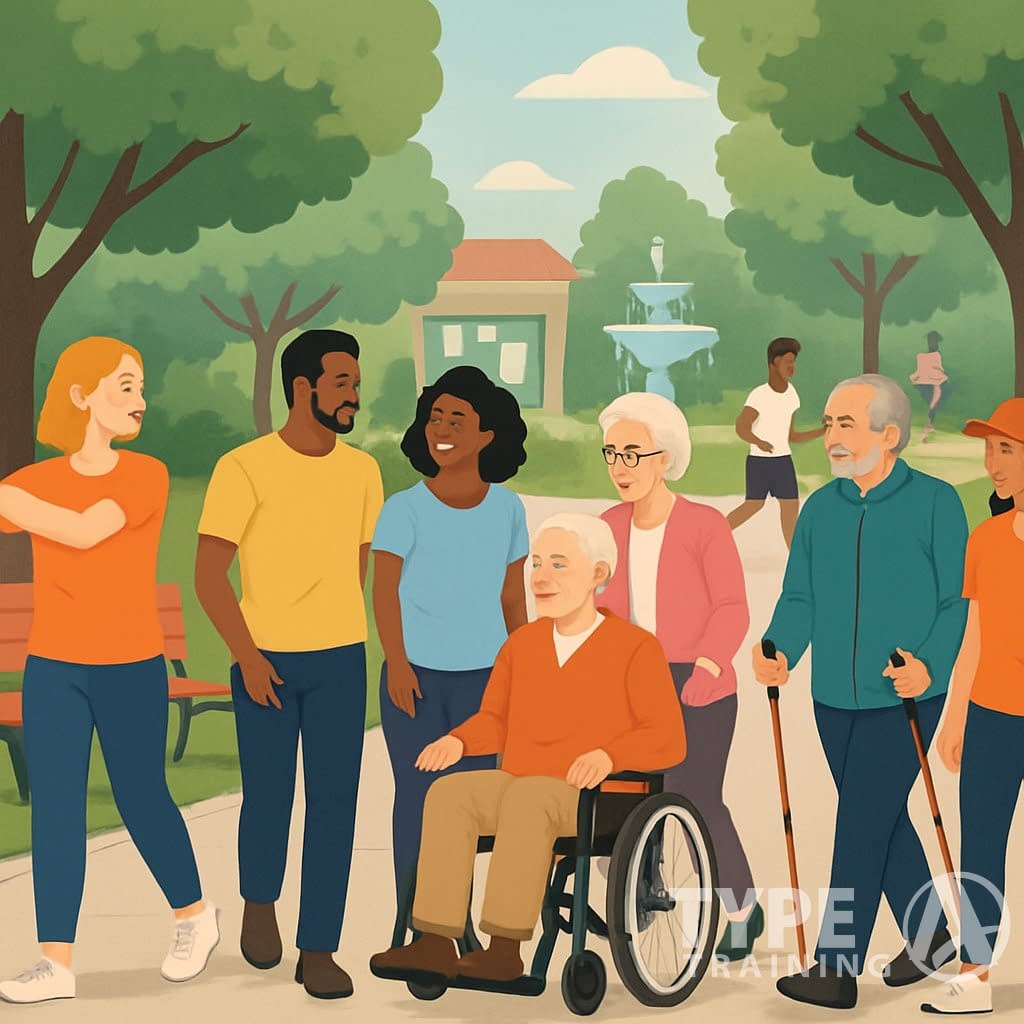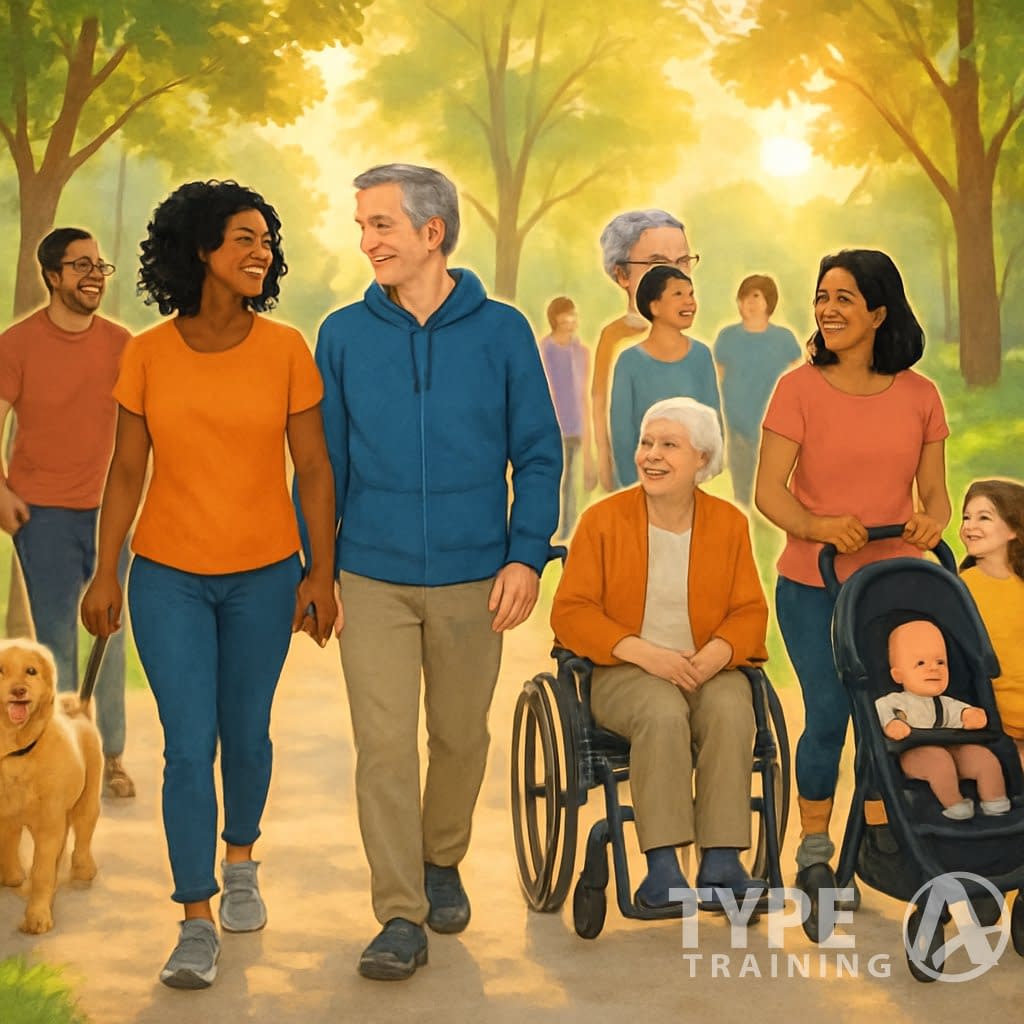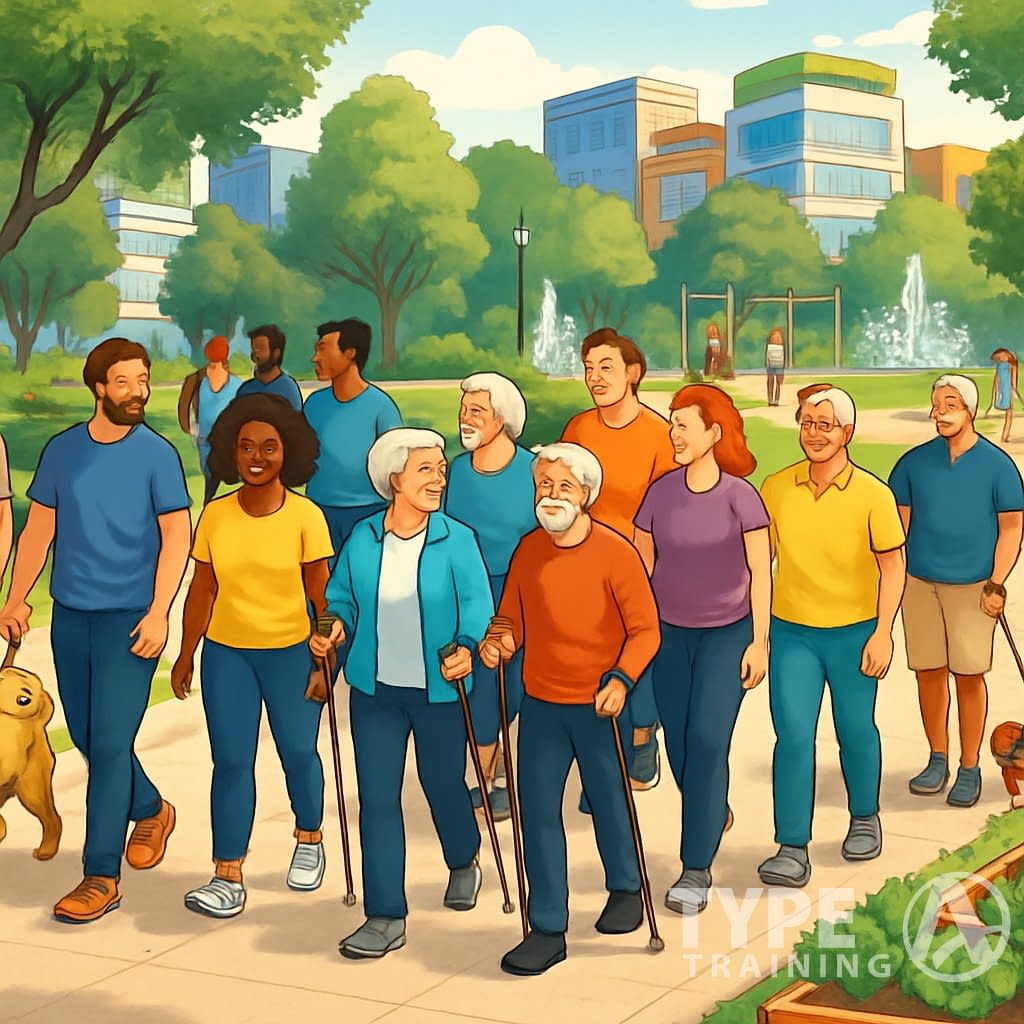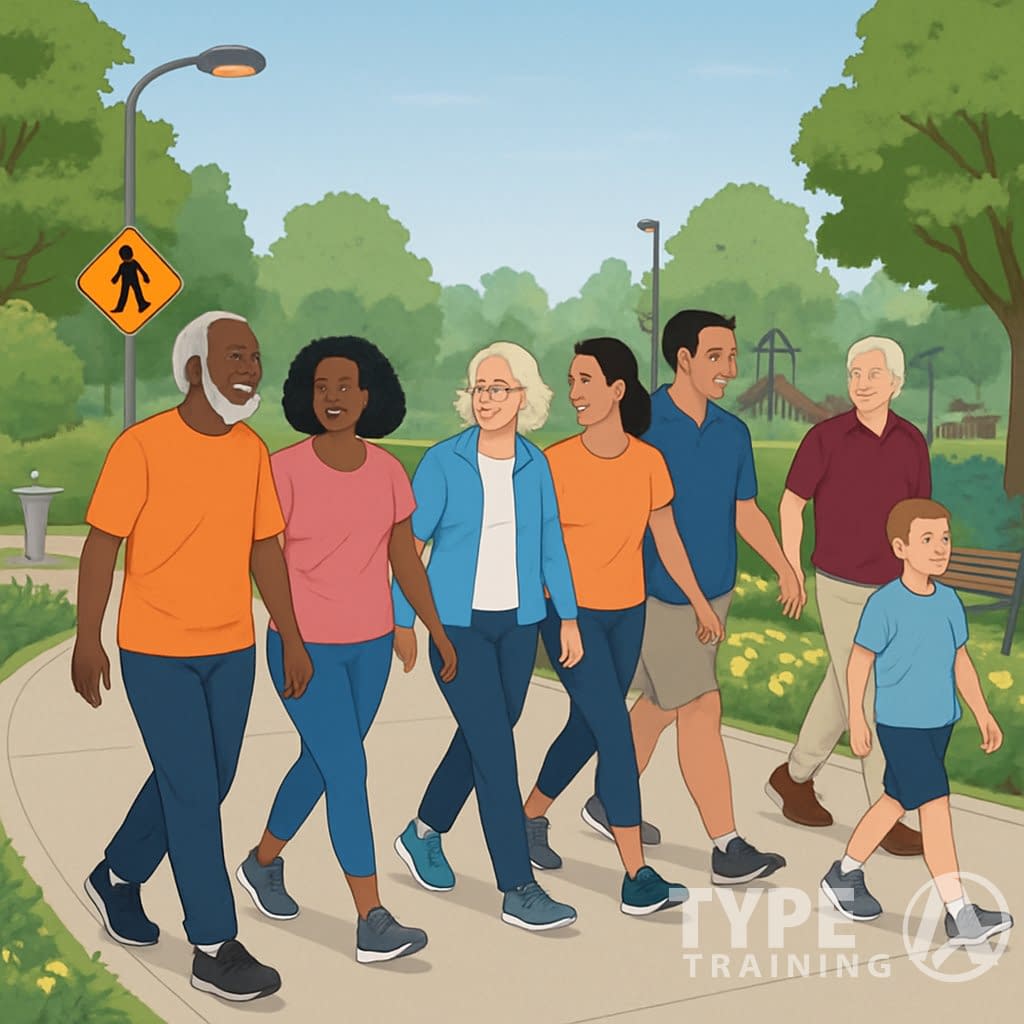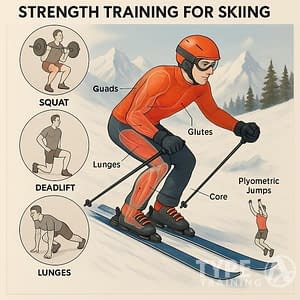Walking with others brings together physical activity and social connection in a way that’s honestly hard to beat. Regular group walks can improve your health and help you form genuine relationships and a sense of community.
Studies show that walking with friends or community groups makes it easier to stick with exercise. People often find the emotional support helps boost their overall well-being.
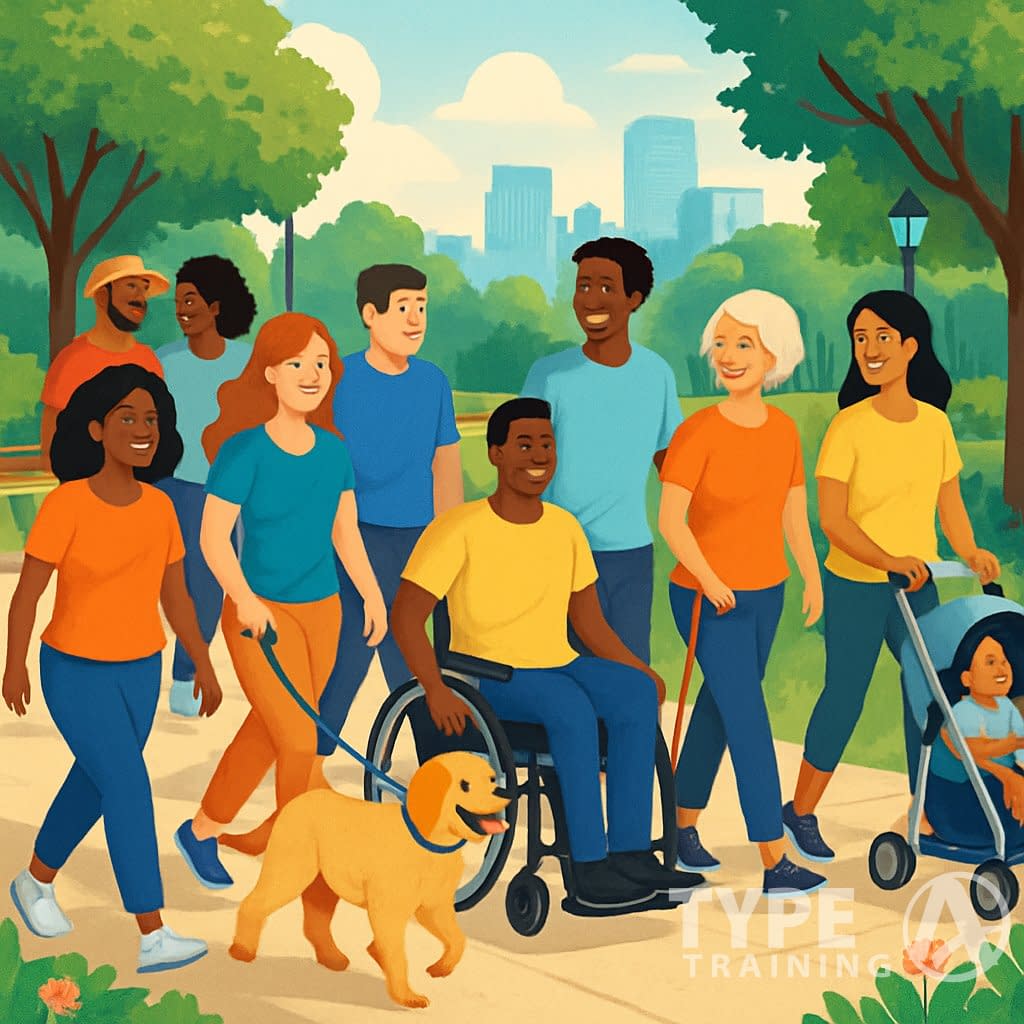
Social walking programs work because they turn exercise into a social event instead of a solo chore. When you join a walking group, you get the physical perks—lower
Popular posts:
These programs can be especially effective when they include community input and culturally relevant elements. It just makes sense, right?
Key Takeaways
- Walking in groups helps people stay consistent with exercise and builds social connections that fight isolation.
- Community-based walking works best when participants help design the program, and when walks happen in safe, easy-to-reach places.
- Social walking brings health benefits like weight management, stress relief, and better heart health.
The Science Behind Social Walking
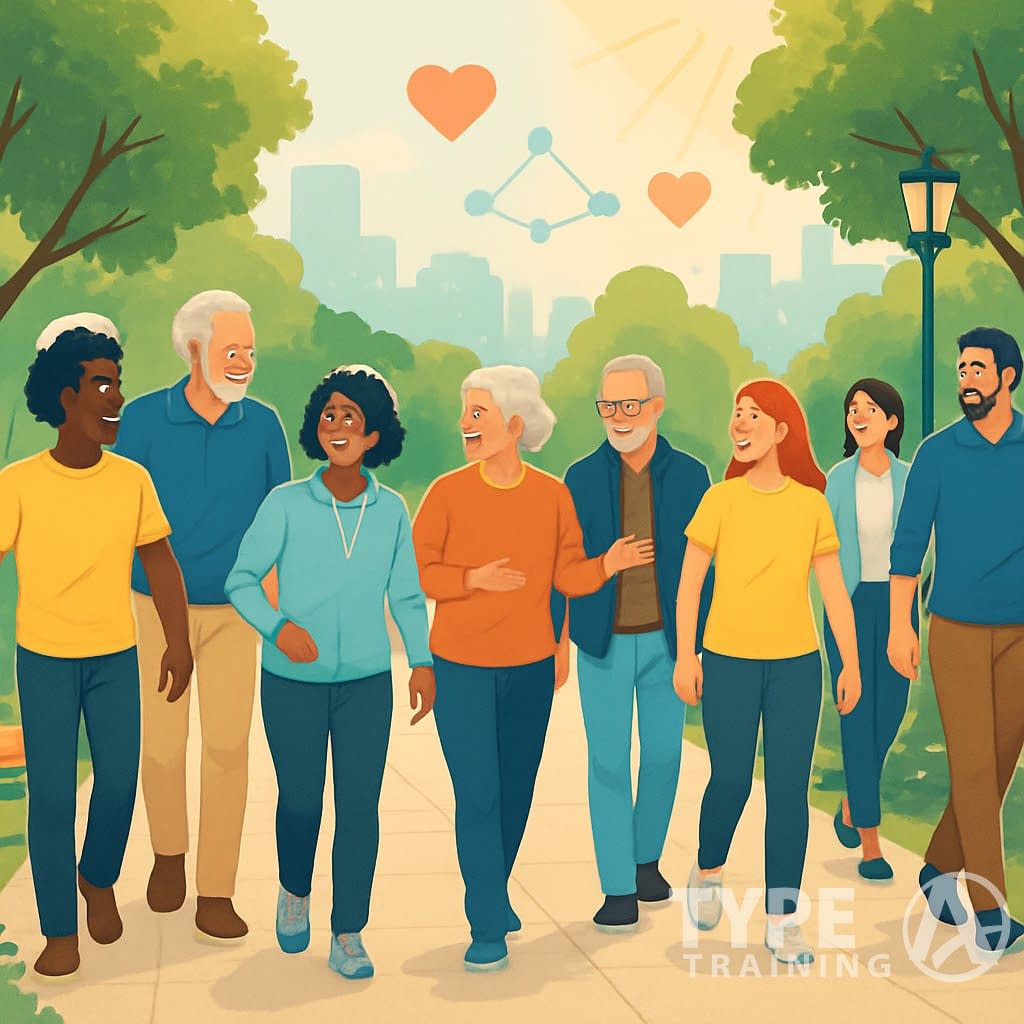
Walking with others mixes movement and connection, and that combo packs a punch for your body and mind. Research keeps confirming the perks when you make walking a social thing.
Health Benefits of Walking With Others
Group walks offer more than just exercise. When you walk with others, you’re more likely to improve both physical activities and social interactions.
The social side helps people stick with regular walking habits. If you know people are counting on you, it’s harder to skip a walk.
Accountability is huge for long-term health. Honestly, sometimes you just need someone waiting for you at the trail.
Social walking sparks conversation, which can melt away stress. The mix of movement and friendly chats can actually release mood-boosting hormones like endorphins and serotonin.
Nature walks crank up the benefits even more. There’s just something about green spaces that lifts your mood beyond what a treadmill can do.
Physical and Mental Health Improvements
Regular social walking boosts your cardiovascular health. Even just 30 minutes can lower blood pressure and cut heart disease risks.
Your body gets better circulation and a stronger immune system, too. All good things.
For your mind, walking actively enhances brain function. People who walk regularly often notice sharper thinking and memory.
Social walks help fight the downsides of too much sitting. Obesity, type 2 diabetes, and other chronic issues become less likely when you get moving.
The mental health impact is real. Walking with others eases symptoms of depression and anxiety. That gentle exercise plus social connection? It’s a winning combo.
Role of Exercise and Physical Activity Guidelines
Health experts say we should get at least 150 minutes of moderate activity each week. Social walking makes that target feel totally doable—no fancy gear required.
Walking is one of the most popular, convenient, and sustainable ways to move more. Almost anyone can join in, no matter their fitness level.
Groups can adjust for different abilities and goals. That flexibility makes walking perfect for community health efforts.
Support from the group plays a key role in shaping health choices. You get motivation and a sense of shared purpose.
Fitness trackers and apps can add to the fun. Just don’t let the numbers steal your joy—sometimes it’s better to just walk and chat.
Essential Elements of Social Walking Strategies
A good social walking program needs a few key ingredients. These pieces make walking enjoyable and help everyone feel connected.
Establishing a Walking Routine
Consistency matters. Set up a regular walking schedule that fits most people’s lives—maybe weekday evenings or weekend mornings.
Weather-protected options like mall walking can keep things going year-round. No excuses when it’s raining, right?
Think about these basics:
- Frequency: Start with 2-3 walks a week
- Duration: Begin at 20-30 minutes, work up to 45-60
- Location: Pick safe, well-lit, easy-to-walk areas
- Meeting point: Make it clear and convenient
Change up your routes to keep things fresh. Try a nature path one day, a city stroll the next.
Track your group’s progress with a shared doc or a simple app. It’s satisfying to see those numbers add up, and it helps spot trends.
Motivation and Accountability
Motivation sticks when others expect you to show up. Share your physical activity goals with walking buddies for extra accountability.
Some strategies that work:
- Pair up so people check in with each other
- Use group chats to confirm who’s coming
- Celebrate milestones—distance, consistency, even just showing up
- Set group challenges that everyone can actually reach
Little rewards help, too. Maybe a monthly coffee outing or a potluck keeps everyone looking forward to the next walk.
Focus on celebrating effort, not scolding absences. Encouragement goes way further than guilt trips.
Social Support Networks
The social side of walking groups is honestly where the magic happens. Building community through walking leads to real connections.
Try these ideas to grow your group’s social vibe:
- Conversation prompts: Bring a few light questions or topics
- Rotating partners: Mix up who walks with whom each time
- Inclusive practices: Make sure everyone feels welcome, no matter their pace
- Extra activities: Plan the occasional potluck or outdoor event
Chats during walks can be spontaneous or planned. Either way, friendships often grow beyond the group.
Pay attention to group dynamics. Help connect folks who might not talk otherwise—sometimes that’s where the best friendships start.
Building a Strong Sense of Community Through Walking
Walking together forges bonds between neighbors and strengthens the fabric of a community. People who walk with others regularly often find their well-being—both physical and mental—gets a real boost.
Fostering Social Connection
Walking sets the stage for social interaction to happen naturally. Unlike formal meetups, walking side-by-side takes the pressure off and makes it easier to talk.
Try these ideas to deepen connections:
- Set a regular weekly walk time
- Use fun conversation starters for new folks
- Pair up walking buddies in larger groups
- Stop at scenic spots for a group chat
Research suggests that formal and informal social opportunities during walks help people feel more connected. These ties often last long after the walk ends.
Shared experiences on the trail become the foundation for real friendships. Many say their social circles grew after joining a walking group.
Creating Inclusive and Supportive Groups
Welcoming walking groups invite people of all ages, backgrounds, and abilities. When everyone feels supported, more folks join in and make connections.
Some ways to keep things inclusive:
- Offer different pace groups—slow, moderate, brisk
- Pick accessible routes with places to rest
- Encourage families, kids, and pets
- Mix up walk times to fit different schedules
Walking groups can really foster social connections and healthy habits. A supportive vibe keeps people coming back.
Celebrate group and individual milestones. Even something small, like marking a walking anniversary, makes people feel seen.
Social Cohesion and Connectedness
Walking brings together people who might never cross paths otherwise. These new connections make communities stronger and more resilient.
Community-wide walking efforts can boost civic pride and improve quality of life. It’s not just about health—it’s about belonging.
Groups often turn into teams that:
- Advocate for better sidewalks and parks
- Organize neighborhood cleanups
- Support local businesses along the route
- Join in community service projects
Friendships that start on a walk can spill over into other parts of life. Many find they feel less alone and more rooted in their neighborhood.
Newcomers especially benefit—they find their footing and connect faster through shared walks.
Combating Loneliness and Isolation With Walking
Walking together builds social bonds that help ease loneliness. Regular social walks offer both health benefits and meaningful connections—something a lot of us could use.
Overcoming Social Distancing and Isolation
Walking groups break the cycle of isolation in a simple, low-pressure way. Loneliness is linked to serious health problems like heart disease, depression, and cognitive decline.
Joining a walking group gives you regular social contact. Walking side-by-side makes conversation easier, especially if face-to-face chatting feels awkward.
Getting started can be as simple as:
- Joining a local walking club
- Starting a small group with a couple of neighbors
- Using apps to find walking buddies nearby
- Attending community walking events
Outdoor community movement brings together physical activity, fresh air, and social connection. It’s a triple win.
Enhancing Mental Well-Being Through Camaraderie
The camaraderie that comes from group walks can give your mental health a real boost. Walking side-by-side just opens up space for conversations that might otherwise feel awkward or forced.
Regular walking partners tend to form meaningful bonds over time. This kind of social environment support is particularly valuable because people start to notice your routine and check in if you’re missing.
Walking groups can help you:
- Reduce stress levels through both exercise and social interaction
- Build consistent relationships with regular walking partners
- Share experiences in a natural, unforced way
- Create accountability for both exercise and social engagement
There’s something about the rhythm of walking that makes conversation flow easier. It helps you connect in a deeper way than you might in more formal settings.
Effective Program Design for Social Walking
If you want a walking program that sticks, you’ll need some thoughtful planning and a clear structure. When a social walking initiative is well-designed, more people join in and actually keep showing up.
Organizing Walking Groups
Walking groups are super flexible and don’t need much gear, so almost anyone can join. To get a group going:
- Set consistent schedules – Pick regular days and times that work for most people
- Designate meeting points in spots that are easy to find and get to
- Create different pace groups so everyone can find their comfort zone
A buddy system can really help people stick with it. Pairing up folks with similar goals or schedules keeps everyone on track.
Try mixing things up with themed walks—nature strolls, local history tours, or “walk and talk” sessions about a specific topic keep things interesting. You might also want to add social support strategies, like group check-ins or little celebrations for milestones.
Collaborating With Health Professionals
If you team up with healthcare providers, your walking program gets a boost of credibility and expertise. Ask local doctors, nurses, or physical therapists to:
- Do quick health assessments for new walkers
- Give short talks on good walking form and how to avoid injuries
- Help set realistic goals for participants
Healthcare professionals can suggest custom walking plans if someone has specific health needs. Their involvement also means doctors might refer patients who need more activity to your group.
You might want to bring in nutritionists or mental health counselors to talk about the full range of walking’s wellness benefits. Local walking advocacy groups can also put you in touch with health pros who specialize in community wellness.
Adapting for Chronic Conditions and Accessibility
Make sure your walking program welcomes everyone, no matter their ability. You can do this by:
- Mapping routes that are flat and wide enough for mobility devices
- Offering seated exercise alternatives that people can do alongside walking
- Providing rest points at regular spots along the way
If someone has a chronic condition, start them off slow—shorter distances, an easy pace—and let them build up as they feel stronger.
Group leaders should know the basics of emergency response and how to spot signs of distress. Set up clear ways for people to speak up about their concerns or limitations.
When choosing routes, check out accessibility guidelines and think about options for different weather, so everyone can join in all year.
Optimizing Environments for Active Lifestyles
The spaces around us really shape how active we are. Communities that focus on active design make it a lot easier to fit movement into your day.
Community Design and Public Space Use
Active design weaves movement into the places we live, work, and play. When a neighborhood is walkable, it’s not just good for exercise—it’s a real boost for social life too.
Look for these in walker-friendly communities:
- Connected sidewalks that are well-lit and kept up
- Visible crosswalks and ways to slow down traffic
- Mixed-use development so homes are close to shops and services
- Public seating areas to encourage people to stop and chat
Want to see these changes? Show up at town meetings or join a local planning group. Built environment interventions have a real track record of making whole communities more active.
Utilizing Parks for Social Activity
Parks are pretty much perfect for walking groups and other activities. They’re safe, accessible spaces where people can move and connect.
When planning walks in parks, think about:
- Time of day – early mornings for bird-watchers, evenings for sunset fans
- Seasonal attractions – spring blossoms, fall colors
- Varied terrain for different fitness levels and interests
- Meetup points near bathrooms and water fountains
Active People, Health Nation encourages social supports like walking groups to get more Americans moving. Parks naturally bring people together.
You can make park walks even better by hosting themed events, family days, or teaming up with local businesses for special activities. It’s a great way to blend exercise with community building.
Prioritizing Safety in Social Walking Activities
Safety turns a simple walk into something you can stick with for the long haul. The right precautions let everyone join in, no matter their age or ability.
Safe Walking Routes and Group Dynamics
Picking the right route is key for group safety. Community walk audits can point out dangerous spots and help push for better infrastructure.
When you’re mapping out a route, look at:
- Traffic—how much and how fast
- Sidewalk condition and width
- Lighting for those early or late walks
- Rest stops and water fountains
- Accessibility for all mobility levels
Group dynamics matter too. Walking with others isn’t just more fun—it’s safer. Use a buddy system so no one has to walk alone, especially in quieter spots.
Pick group leaders who can handle emergencies and keep everyone together. Leaders should have a phone, basic first aid, and emergency contacts for the group.
Promoting Brisk Walking Safely
Brisk walking delivers significant health benefits when you do it right. Adults need about 150 minutes of moderate activity each week.
You can hit that goal with five brisk, 30-minute walks. If you’re just starting out, take it easy.
Ramp up your pace and time bit by bit. That way, you’re less likely to end up sore or hurt.
A few safety tips come to mind:
- Wear
shoes that actually support your feet and cushion your steps. - Drink water—before, during, after. It matters more than you might think.
- Grab a reflective vest or clip-on light if it’s dark or foggy out.
- Stretch a little before and after you walk, just to keep things loose.
- Try the “talk test”—if you can chat but not belt out a song, you’re probably at the right intensity.
Weather can throw you a curveball. On hot days, aim for early mornings or evenings and don’t forget sunscreen.
If it’s cold, layer up and keep an eye out for slippery ice patches.

